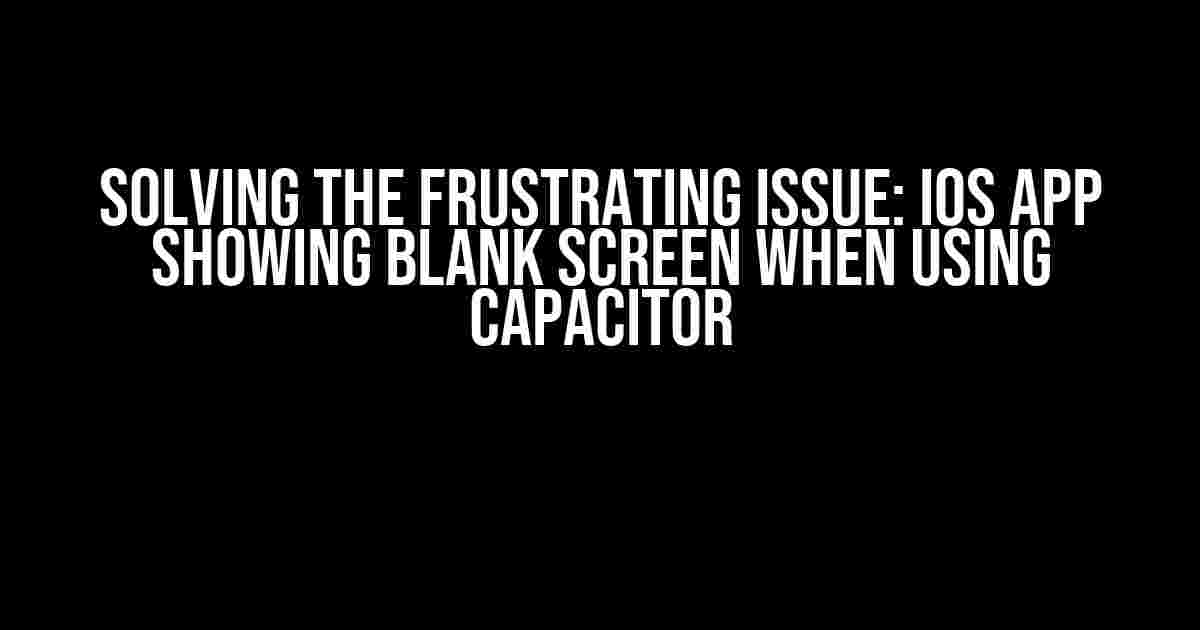Are you tired of wrestling with your iOS app, only to be left staring at a frustrating blank screen? You’re not alone! Many developers have encountered this issue when using Capacitor, a popular tool for building hybrid mobile apps. But fear not, dear coder! In this comprehensive guide, we’ll delve into the common causes and provide straightforward solutions to get your app up and running smoothly.
- Understanding the Problem: What’s Causing the Blank Screen?
- Solution 1: Verify Capacitor Configuration
- Solution 2: Update Plugins and Dependencies
- Solution 3: Check iOS Version Compatibility
- Solution 4: Troubleshoot Xcode Issues
- Solution 5: Disable Web Security (Temporary Fix)
- Conclusion
- Additional Resources
Understanding the Problem: What’s Causing the Blank Screen?
Before we dive into the fixes, it’s essential to understand the potential culprits behind the issue. Here are some common reasons why your iOS app might be displaying a blank screen when using Capacitor:
- Incorrect Capacitor Configuration: Misconfigured Capacitor settings can lead to a blank screen. Make sure you’ve followed the official documentation for setup and installation.
- Plugin Issues: Outdated or incompatible plugins can cause conflicts, resulting in a blank screen. Keep your plugins up-to-date and ensure they’re compatible with your Capacitor version.
- iOS Version Compatibility: Capacitor might not be optimized for the latest iOS version, leading to compatibility issues. Ensure you’re running the latest Capacitor version and that it’s compatible with your iOS version.
- Xcode Issues: Xcode-related problems, such as outdated software or corrupted projects, can cause a blank screen. Try cleaning your Xcode project or reinstalling Xcode to resolve the issue.
Solution 1: Verify Capacitor Configuration
Let’s start with the basics! Ensure your Capacitor configuration is correct by following these steps:
ionic capacitor add ios(if you haven’t already)- In your
capacitor.config.jsfile, verify that theiosplatform is listed: - In your
ionic.config.jsonfile, ensure thebuildcommand is set tocapacitor build ios:
{
"plugins": [...],
"platforms": ["ios"]
}
{
"projects": {
"app": {
"build": {
"builder": "capacitor",
"commands": [
"capacitor build ios"
]
}
}
}
}
Solution 2: Update Plugins and Dependencies
Outdated plugins can be a significant contributor to the blank screen issue. Update your plugins and dependencies using the following steps:
- Run
npm outdatedto identify outdated packages. - Update packages using
npm install(replace@latest - Run
ionic capacitor updateto update Capacitor and its dependencies.
Solution 3: Check iOS Version Compatibility
Capacitor might not be optimized for the latest iOS version, leading to compatibility issues. Ensure you’re running the latest Capacitor version and that it’s compatible with your iOS version:
- Check the Capacitor version using
ionic capacitor --version. - Visit the Capacitor release notes to determine the latest version compatible with your iOS version.
- Update Capacitor using
npm install @capacitor/core@latest(replace@latestwith the compatible version).
Solution 4: Troubleshoot Xcode Issues
Xcode-related problems can also cause a blank screen. Try the following troubleshooting steps:
ionic capacitor clean iosto clean the Capacitor project.- Delete the DerivedData folder by running
rm -rf ~/Library/Developer/Xcode/DerivedData. - Open your Xcode project and clean the project by going to
Product>Clean. - Try reinstalling Xcode or resetting the Xcode settings to their default values.
Solution 5: Disable Web Security (Temporary Fix)
In some cases, disabling web security might resolve the blank screen issue. However, this is a temporary fix and should not be used in production:
- In your
Info.plistfile, add the following code: - Rebuild your app using
ionic capacitor build ios.
<key>NSAppTransportSecurity</key>
<dict>
<key>NSAllowsArbitraryLoads</key>
<true/>
</dict>
Conclusion
By following these solutions, you should be able to resolve the frustrating issue of your iOS app showing a blank screen when using Capacitor. Remember to verify your Capacitor configuration, update plugins and dependencies, check iOS version compatibility, troubleshoot Xcode issues, and disable web security (if necessary). If you’re still experiencing issues, don’t hesitate to reach out to the Capacitor community or seek further assistance.
| Solution | Description |
|---|---|
| Verify Capacitor Configuration | Ensure correct Capacitor setup and installation |
| Update Plugins and Dependencies | Update outdated plugins and dependencies |
| Check iOS Version Compatibility | Ensure Capacitor is compatible with the latest iOS version |
| Troubleshoot Xcode Issues | Resolve Xcode-related problems |
| Disable Web Security (Temporary Fix) | Disable web security to resolve the issue (not recommended for production) |
Remember, solving the blank screen issue is just the first step. After resolving the problem, ensure your app is optimized for performance, security, and user experience.
Additional Resources
For further assistance and resources, check out the following links:
By following this comprehensive guide, you should be able to resolve the frustrating issue of your iOS app showing a blank screen when using Capacitor. Happy coding!
Here is the HTML code for the FAQ section about “IOS app showing blank screen when using Capacitor”:
Frequently Asked Question
Get answers to the most common issues with Capacitor and IOS apps showing blank screens!
Why is my IOS app showing a blank screen when using Capacitor?
This is usually due to a compatibility issue between Capacitor and the IOS platform. Make sure you have the latest versions of Capacitor and Xcode installed. Also, try deleting the `DerivedData` folder and rebuilding your app.
How can I troubleshoot this issue?
First, check the Xcode console for any error messages. Then, try running your app on a different device or simulator to see if the issue is device-specific. You can also try resetting the simulator or deleting the app and reinstalling it.
Is this issue related to the WebView?
Yes, the blank screen issue can be related to the WebView. Try updating the WebView package to the latest version or disabling any custom WebView settings. You can also try using a different WebView plugin to see if the issue persists.
Can I use a third-party library to fix this issue?
Yes, there are several third-party libraries available that can help resolve the blank screen issue. For example, you can try using a library like `capacitor-plugin-webview` which provides additional configuration options for the WebView.
Where can I find more resources to help with this issue?
You can find more resources on the official Capacitor documentation, the Capacitor community forum, or by searching online for tutorials and guides specific to your issue. Additionally, you can try reaching out to the Capacitor support team for further assistance.


